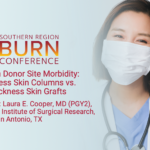Abstract | March 2, 2021
Reduction in Donor Site Morbidity: Full-Thickness Skin Columns vs. Split-Thickness Skin Grafts
Learning Objectives
- Compare re-epithelialization, pigmentation, and contraction of FTSC donor sites and standard of care STSG donor sites;
- Determine if FTSC donor sites display less morbidity than standard of care STSG donor sites;
- Conclude the maximal number of skin columns that can be harvested from a FTSC donor site without increasing morbidity.
Introduction: Split-thickness skin grafts (STSGs) are the mainstay of treatment for wounds too large to heal via linear closure. However, they fail to adequately reproduce basic functions of skin such as temperature regulation, pliability, uniform texture and color, and lubrication. Additionally, STSG donor sites subject patients to new, open wounds that can serve as a source of significant pain and result in scarring. Full-thickness skin grafts (FTSGs) have an improved cosmetic outcome as compared to STSGs and can better recapitulate near-normal skin appearance and function. However, there are few sites that can serve as donors and requirement for “take” is greater, resulting in higher failure rates for non-optimized wound beds. To address these limitations, we compare donor sites from tangentially-obtained STSG to orthogonally-obtained fullthickness skin columns (FTSCs) which consist of all skin layers and components in an effort to capture the benefits of FTSGs while mitigating the downsides.
Methods: Donor sites were created on the dorsum of anesthetized swine (Sus scrofa domestica). STSG donor sites were harvested with a dermatome at a depth of 12/1000 inch and compared to FTSC donor sites with varying harvest ratios of 1.5mm diameter skin columns. Donor site morbidity was assessed in terms of differences in pigmentation, reepithelialization, and contraction from post-burn day (PBD) 0 to PBD 90.
Results: FTSC donor sites showed less dyspigmentation and faster re-epithelialization as compared to STSG. All of the FTSC donor sites had re-epithelized by PBD 7. STSG donor sites were completely re-epithelialized by PBD 21. No differences in contraction were seen in this porcine model.
Conclusions: Preliminary studies show that FTSC donor sites re-epithelialize more quickly and have less dyspigmentation as compared to STSG donor sites. Ongoing experiments are assessing the maximal number of FTSC that can be harvested while still maintaining morbidity less than that seen with STSG donor sites.
References and Resources
- Tam, J., et al., Reconstitution of full-thickness skin by microcolumn grafting. J Tissue Eng Regen Med, 2017. 11(10): p. 2796-2805.
- Tam, J., et al., Fractional Skin Harvesting: Autologous Skin Grafting without Donor-site Morbidity. Plast Reconstr Surg Glob Open, 2013. 1(6): p. e47

